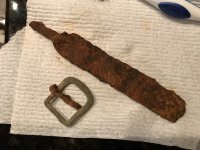Primerfinder
Tenderfoot
I am brand new and as green as they come. I have a total of 2 hours of hunting under my belt, so please forgive the ignorance. I have bought some property 2 miles from Colonel Nisbet's still partially standing home. I have bought the land where I believe that he trained his soldiers (info from reading books and locals). I believe I have found an old horse bridal buckle and an old rasp or file. My question is, is this what I have and how do I tell if they are old and not just form the 1970's or something? Thanks for any info.





